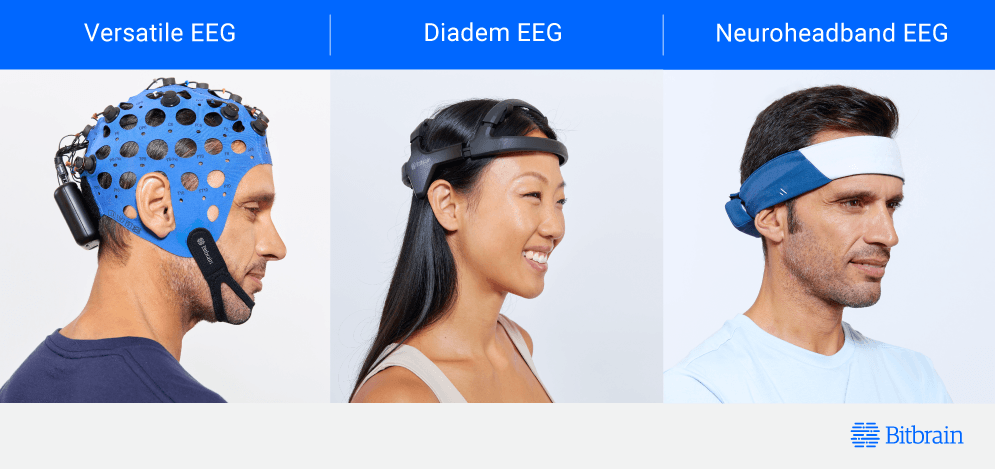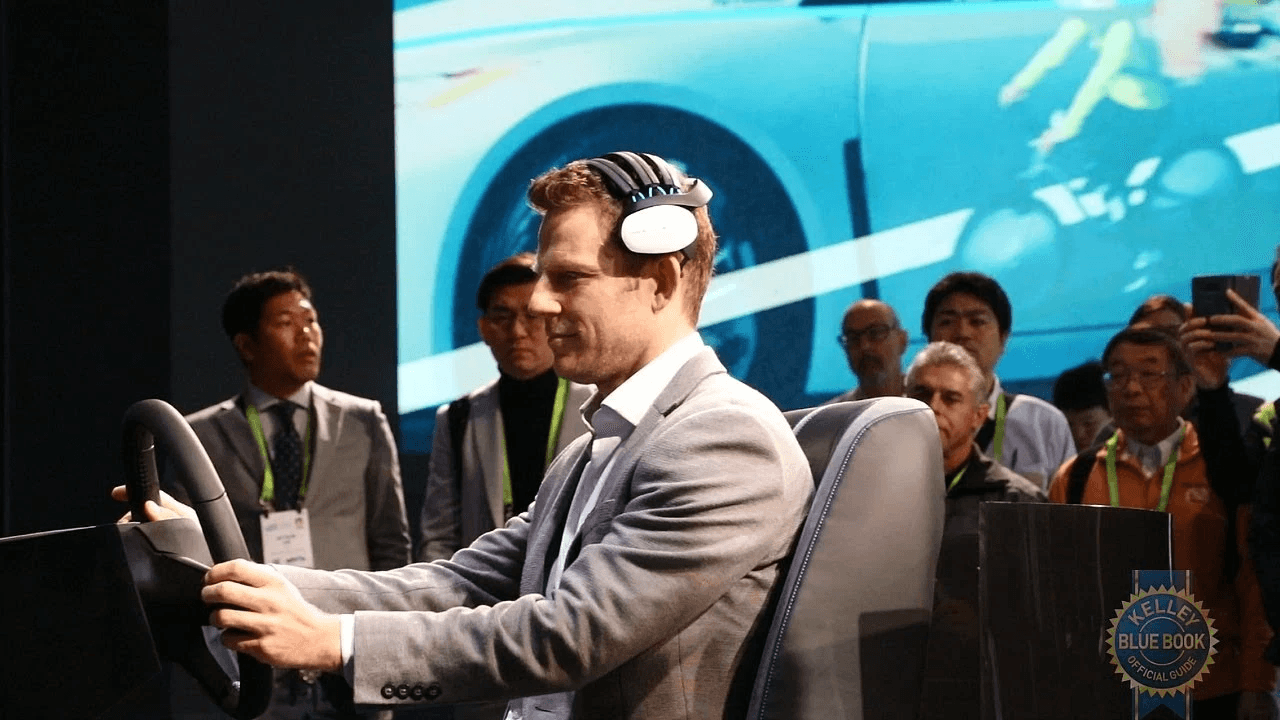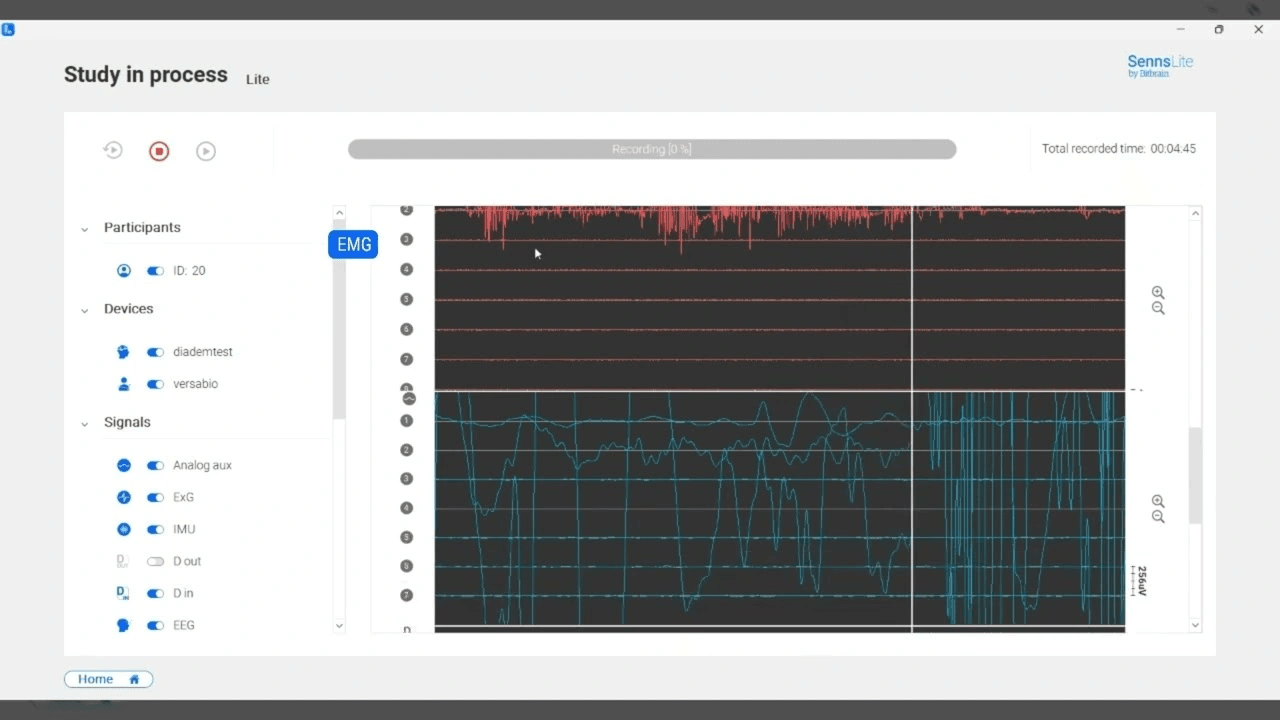How to Select a Dry-EEG Headset for your Research Application
Dry-EEG systems can open the door for the application of neuroscience in real-world settings, and the market to a new generation of products and services based on neurotechnology. However, there are many open questions related to their reliability, accuracy and signal quality. This post will give the reader solid arguments for selecting a technology that fits the application requirements.
What is a dry-EEG headset?
The difference between electroencephalography (EEG) systems is primarily the type of electrolytic substance used to improve the conductivity between the
EEG electrode/sensor and the skin (Liao 2012):
- Dry-EEG: no substance
- Water-based EEG: tap water humidity
- Textile EEG: wearable EEG based on smart textiles
- Saline EEG: saline solutions
- Gel EEG: electrolytic gels

From left to right: Bitbrain EEG solutions, Versatile EEG (water-based sensors), Diadem (dry-EEG) and Ikon (textile-EEG)
Semi-dry, saline, or gel-based EEGs are also referred to as wet EEGs. The fact that a substance is required to improve the conductivity between the sensor and the scalp has a very important impact on the headset usability and comfort, and thus, in the final user experience and possible applications.
Dry-EEG electrodes do not require the use of any substance, making contact directly with the scalp. Their main advantage is that they are fast to place, do not require any additional instruments like syringes or gel cans, are usually comfortable to wear, do not require the head to be cleaned after usage, and do not require heavy hygienic procedures on the equipment afterwards. Their main disadvantage is the high contact impedance between the sensor and the skin, which requires the dry sensor and amplifier layers to be able to deal with more EEG artifacts and noise. These layers must compensate for this drawback with higher performance and more sophisticated features than those technologies with electrodes that use electrolytic substances, in order to achieve the same signal quality (higher input impedance to avoid signal attenuation and active shielding techniques to minimize coupled artifacts, see Li et al., 2018).
Accordingly, better usability and comfort of dry-EEG systems can affect negatively both the reliability and the accuracy of the device, key features to consider when selecting an EEG headset. The design of the sensors, amplifier, and cable of the dry-EEG headsets need much higher performance features than wet-EEG devices to obtain a high-quality EEG signal.
What are dry EEG headsets useful for?
A significant area of neuroscience research addresses a new challenge: to shift the understanding of human behavior from controlled scenarios in research laboratories to real-world settings. In addition, a new generation of neurotechnologies and brain-computer interfaces is starting to reach new markets. Both research and business opportunities are creating the need for a new generation of EEG with very novel requirements: ease of use, comfortability, mobility, and resistance to artifacts. When well designed, dry-EEG systems directly address all these features, offering compliance with new use-cases and research scenarios that were not possible to access before.
For example, these dry-EEG technologies are approaching research and business applications that allow self-placement by the user, providing more autonomy in health scenarios. This innovation goes well beyond what is possible with wet-EEG systems.
Bitbrain Diadem EEG self placement tutorial video
Dry-EEG electrodes vs wet-EEG electrodes in application
Although a dry-EEG headset can be used to record EEG in almost any setup, the main purpose of these technologies is to address real-world environments or professional products or services.
An easy way to fit both dry and wet-based electrodes EEGs in a general research pipeline is:
-
Phase 1 - Exploratory research phase: use in-lab research technologies to understand human behavior in controlled situations. At this step, the priorities are to obtain measurements with a large number of sensors, with high coverture of the brain, and with very high resolution and accuracy.
-
Phase 2 - Optimization of the application: use EEG signal processing techniques to understand where and how the neural correlates underlying the behavior can be measured.
-
Phase 3 - Application-oriented phase: use out-of-lab research and application technologies (dry-EEG headsets) to understand human behavior in natural scenarios. In this case, the priority is to have easy to use and comfortable EEG technologies, with sensors only over the relevant brain areas (measuring only the brain electrical activity we need to measure), with mobility and resistance to artifacts (to handle free of movements).
So, the main application focus of wet-based EEG is usually complementary to dry-EEG, as they are used in different stages of this research pipeline. See some examples below.
High-density vs low-density dry-EEG headsets
As mentioned before, low-density dry-EEG electrodes are designed to target later stages of research and development (usually when one already knows the brain areas to measure, based on their own or others’ research). Then, by reducing the number of electrodes, the dry-EEG headset design can focus on other aspects like usability, ergonomics, comfort, and mobility. That is the main advantage of these technologies.
However, high-density dry-electrodes (32 electrodes or more) can also be conceived to be used in the same research stage as wet-based EEG systems with shower-cap designs. In that case, research grade dry-EEG technologies have the advantage of eliminating the electrolytic substance (cleanliness of the equipment, no need to wash the head afterward, etc), but usually sacrificing usability or ergonomics.
Important features of dry-EEG systems
Apart from having dry-EEG sensors, it is important to have an acquisition system that is reliable and accurate enough for the final application. The main message is that the lower the electrolytic properties required by the sensor are, the higher the performance of the sensor, cable shielding and the amplifiers (Li et al., 2018). Based on the most common characteristics shown in the literature (Gargiulo et. al., 2010; Pinegger et. al., 2016; Tallgren et. al., 2005), we provide here a comprehensive list of the most important features that impact the reliability and accuracy of a dry-EEG system.
Notice that even though EEG amplifiers correctly designed for dry or semi-dry EEG sensors can work perfectly with saline or gel-based EEG sensors, the opposite may not be true, and we may expect lower SNR with a very high level of noise and artifacts.
Multimodal research
Read this article to learn more about multimodal research, explore combinations of EEG and other technologies for neuroscience research projects, and learn how to evaluate the best options for each scenario.

Figure 3: Diagram of all the biosignals that can be measured through multimodal research.
Some of the scientific publications that employ a multimodal approach include Framing, risk perception, and social health campaigns: A neuroscientific analysis (Fernandez-Lores et al., 2024), which utilised a dry-EEG headset, Bitbrain Diadem, with the biosignal amplifier Ring. Same technology used in the paper Evaluating the Effect of Speed and Acceleration on Human Factors during an Assembly Task in Human–Robot Interaction (HRI) (Apraiz et al, 2025). There are more examples of scientific publications and open-access EEG datasets registered with both dry-EEG and water-based EEG at the Bitbrain website.
In this video, the setup features the Bitbrain Diadem EEG headset combined with the Versatile Bio biosignal amplifier, both recorded simultaneously using Bitbrain’s SennsLite software. This dry-EEG system, integrated with additional biosensors and synchronized via dedicated software, enables high-quality, multimodal data acquisition—maximizing the research potential.
Real-world examples of dry-EEG systems in use
Multimodal Research Projects Using Dry-EEG and Other Biosensors in Real-Life Scenarios
Impact study on an exhibition at the Maritime Museum of San Sebastián [12]. This study was performed in 2020 by the Human Factor and user experience (HU&UX) laboratory, from TECNALIA Research and Innovation.
The contents of the study were “to identify the exhibition’s resources that are the most attractive to the visitors” (Sara Sillaurren, ICT Project Manager and one of the main researchers on this study). As such, the main objective was to “create a final report that determines the key elements of the exposition that evoke the biggest impact on the public, to guide the museum managers on future expositions.”
To this end, the research required maximum controlled movement allowance and comfort on the subject’s side. The exposition’s environmental conditions required for the tests to extract relevant information on the unconscious response of the subjects to different stimuli: texts, images, videos, and smells.
The HU&UX research group used:
- EEG recording – Diadem EEG.
- GSR and BVP recording – Ring.
- Eye-tracking recording – Tobii Pro Glasses 3 (wireless)
- Indoor Positioning System – InTrack (not available commercially).
- The multimodal recording was performed with SennsLab, and the data analysis was done with the SennsCloud Platform and SennsMetrics.
With these tools, the research group extracted a full cognitive and emotional analysis on the public’s response, segmented by age groups. The relevant analysis results were extracted by separating the exhibition into distinct thematic areas and categorizing the stimuli presented on each one of them.

Figure 6: Diagram of multimodal out-lab scenario: Tobii Pro Glasses 3, Bitbrain Diadem and Ring. Data flow that specifies the steps followed to carry out the study and obtain the results.
Other research projects using Dry-EEG
Home-based BCI for motor neurorehabilitation of SCI patients
The implantation was thanks to the H2020 MoreGrasp EU project. See more details here.
Driving monitoring and enhancement
See more detailes of the implantation in Nissan Group here.
 Presentation of the Nissan Brain-to-Vehicle Driving Simulator at CES
Presentation of the Nissan Brain-to-Vehicle Driving Simulator at CES
Conclusions
Dry electrodes EEG headsets are starting to open the door for the application of neuroscience in real-world settings, and the market to a new generation of products (research and medical devices, and commercial EEG headsets) and services based neurotechnology. However, the selection of an EEG system is not an easy task. These two questions can provide a starting point::
-
Where are you in the research process?
-
If you are in exploratory phases where the priority is to obtain a deep understanding of brain activity measurements, you may want to consider starting with a wet-EEG system.
-
If you are in applied phases where you know what you need to measure (a subset of sensors) and the priority is usability and comfort, then you may want to consider a dry-EEG system.
-
-
It is only about dry-EEG sensors? It is about dry-EEG systems, including sensors, cable, and amplifier layers. The selection of the sensor type determines the application due to the ergonomics and usability that they provide, but this selection cannot be done without taking into account the signal transportation -shielding-, and biosignal amplifier features.
Once you know this and still you think that you need a dry-EEG headset, it is all about using this information to better understand features and why they are important in the selection process.
About the author
Javier Minguez, Ph.D. - Chief Scientific Director of Bitbrain (Google Scholar, LinkedIn, Twitter)
Professor of the Department of Information Technology and Principal Investigator of the Neurotechnology Research Team of the University of Zaragoza (Spain). Professor and guest researcher at more than 10 academic institutions such as Stanford University (USA), Tubingen University (Germany) and IE Business School (Spain), etc.
110+ research publications and 5+ patents in the areas of neuroscience, neural engineering, brain-computer interfaces, human-computer interaction, cognitive and motor neurorehabilitation, intelligent robotics and market research.
R & D achievements: several pioneer prototypes of robots controlled by brain-computer interfaces (a wheelchair, a telepresence robot and a robotic arm), the first neurotechnology for personalized cognitive improvement and the first neurotechnology for the detection of emotions.
Minguez has received more than 25 international awards such as the Ibero-American Award for Innovation and Entrepreneurship, the second prize of the European Commission - Best ICT Company and Best Investment Opportunity, and the Everis Foundation International Business Award.
Speaker in more than 300 events related to research and innovation, such as the Royal Academy of Medicine of Spain, the ICT Conference of the EU,several International Conferences of the IEEE, among others.
Bibliography
- Liao, Lun-De & Lin, Chin-Teng & McDowell, Kaleb & Wickenden, Alma & Gramann, Klaus & Jung, Tzyy-Ping & Ko, Li-Wei & Chang, Jyh-Yeong. (2012). Biosensor Technologies for Augmented Brain-Computer Interfaces in the Next Decades. Proceedings of the IEEE. 100. 10.1109/JPROC.2012.2184829.
- Allen, J. J. B., & Cohen, M. X. (2010). Deconstructing the “resting” state: exploring the temporal dynamics of frontal alpha asymmetry as an endophenotype for depression. Frontiers in Human Neuroscience, 4(December), 232. https://doi.org/10.3389/fnhum.2010.00232
- Li, G., Wang, S., & Duan, Y. Y. (2018). Towards conductive-gel-free electrodes: Understanding the wet electrode, semi-dry electrode and dry electrode-skin interface impedance using electrochemical impedance spectroscopy fitting. Sensors and Actuators B: Chemical, 277, 250–260. DOI: 10.1016/j.snb.2018.08.155
- Gargiulo, G., Calvo, R. A., Bifulco, P., Cesarelli, M., Jin, C., Mohamed, A., & Schaik, A. V. (2010). A new EEG recording system for passive dry electrodes. Clinical Neurophysiology, 121(5), 686–693. DOI: 10.1016/j.clinph.2009.12.025
- Pinegger, A., Wriessnegger, S. C., Faller, J., & Müller-Putz, G. R. (2016). Evaluation of Different EEG Acquisition Systems Concerning Their Suitability for Building a Brain-Computer Interface: Case Studies. Frontiers in Neuroscience, 10. DOI: 10.3389/fnins.2016.00441
- Tallgren, P., Vanhatalo, S., Kaila, K., & Voipio, J. (2005). Evaluation of commercially available electrodes and gels for the recording of slow EEG potentials. Clinical Neurophysiology, 116(4), 799–806. DOI: 10.1016/j.clinph.2004.10.001
- Escolano C., XXX (2020). In submitted to Frontiers of Neuroscience.
You might also be interested in:
- Main features of the EEG sensor layer explained
- An introduction to brain-computer interface using EEG signals
- Advances in motor neuroprosthetics improve mobility in tetraplegics
- What is neurorehabilitation and 4 leading projects in Europe
- Will machines ever feel emotions?
- Overview of cognitive rehabilitation and stimulation therapies in dementia
- The Use of EEG for ADHD Diagnosis and Treatment
- The Procedure and Uses of the EEG Test


